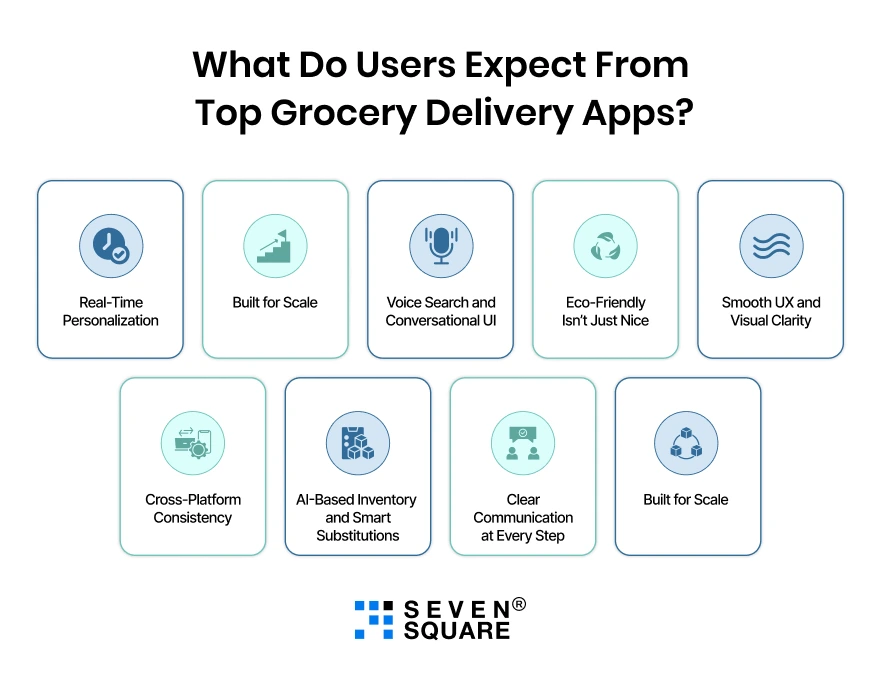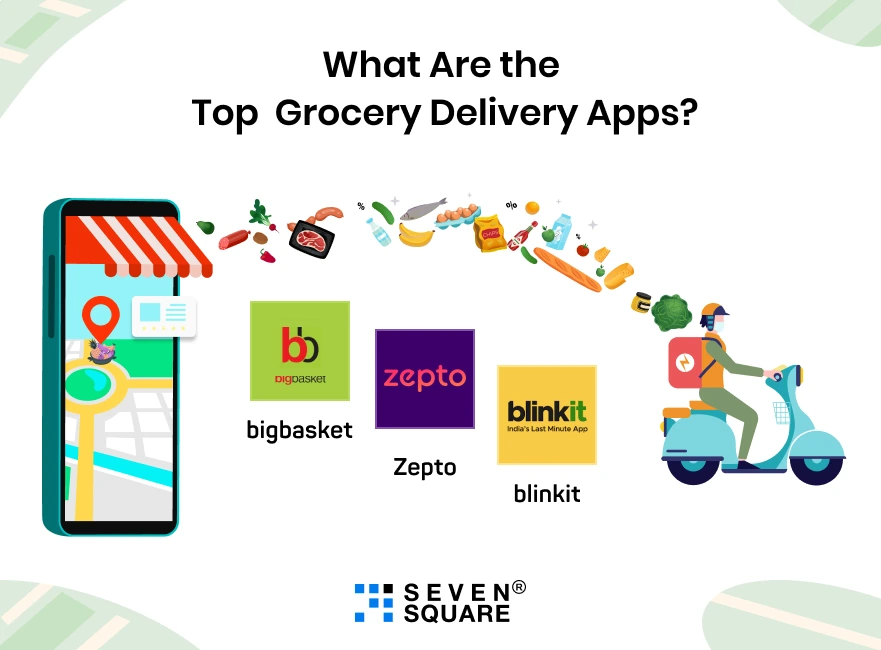You’re in the middle of dinner prep. The onions are sizzling, and you reach for tomatoes, gone.
You grab your phone to reorder groceries, but the app takes forever to load.
It shows irrelevant suggestions and gives you the same outdated user experience it had two years ago.
You close it, frustrated, and wonder: isn’t there a better grocery app in 2025?
As a product leader, you’re not just building an app, you’re solving a daily-life problem that people genuinely care about.
And in 2025, user expectations from grocery apps are sky-high.
They expect more than just delivery. They expect speed, personalization, eco-consciousness, and intelligent interfaces.
We’ve helped fast-growing startups and retail giants build custom solutions across various industries.
So if you plan to build a best grocery delivery app this year, this blog is for you.
Let’s explore what the best grocery app in 2025 looks like and what are the top grocery delivery app features.
What Do Users Expect From Top Grocery Delivery Apps?

Here you can see some of the user expectations from online grocery shopping apps.
If you want to build the best grocery app then you should add these features to it.
1. Real-Time Personalization: The New Baseline
Forget generic recommendations. In 2025, personalized grocery shopping is the baseline.
Users expect smart suggestions based on their diet, allergies, past purchases, and even the season.
- AI should learn user preferences over time.
- Data models must predict needs before users realize them.
- Offer personalized bundles (e.g., “Your weekly vegan pack”).
We implemented this in a grocery app for a Southeast Asian client & its conversions increased by 28% within three months.
2. Speed Still Wins
Quick delivery is everything. Users expect groceries in under 30 minutes in metro areas.
That means optimizing logistics, real-time inventory tracking, and intelligent routing algorithms.
At Seven Square, we prioritize performance engineering from day one. A delay in backend syncing or checkout speed is a conversion killer.
Apps like Zepto and Blinkit are winning here. If you’re not thinking in terms of milliseconds, your competition is.
Zepto’s migration to MongoDB is one of the best examples.
3. Voice Search and Conversational UI
Typing a grocery list? That’s 2023.
In 2025, voice-assisted grocery shopping is quickly becoming mainstream.
Think: “Hey app, reorder last week’s breakfast list.”
- Natural language understanding (NLU) is now mature enough to handle complex requests.
- Conversational interfaces are more intuitive for users multitasking in the kitchen.
This also opens up accessibility to users with disabilities or low literacy, an overlooked demographic.
4. Eco-Friendly Isn’t Just Nice: It’s Expected
More than ever, users are choosing brands that align with their values. And for grocery apps, that means eco-friendly grocery delivery practices.
- Reusable or biodegradable packaging
- Electric vehicle fleets
- Option to offset carbon footprints
One of our clients introduced an eco-mode for deliveries & 60% of users opted in.
5. Smooth UX and Visual Clarity
Design is no longer just aesthetics, UX is product strategy. Users expect:
- Clear CTA buttons
- Frictionless onboarding
- Easy search and filters
- Minimal steps to checkout
We’ve seen apps double their retention just by reworking the onboarding and adding contextual nudges.
6. Cross-Platform Consistency
Whether it’s iOS, Android, PWA, or a smartwatch, users want a consistent experience.
Your app should feel the same on all platforms: fast, familiar, and frictionless.
And yes, that means no bugs on Android 13 and no slow loads on older iPhones.
Pro tip: Build modular UI components from the start.
7. AI-Based Inventory and Smart Substitutions
One of the most frustrating user experiences? Adding 12 items to the cart only to find 4 are out of stock. Or worse, getting random substitutes.
Smart grocery apps in 2025 use AI for:
- Predictive inventory management
- Smart substitutions (based on dietary preferences and brand loyalty)
- Real-time restock alerts
We helped a mid-size grocery chain implement this.
Result? 40% fewer cart abandonments.
8. Clear Communication at Every Step
Nothing erodes trust like uncertainty. “Your order is being processed” doesn’t cut it anymore.
Users want:
- Real-time delivery tracking
- ETAs that update in real-time
- Transparent refund and replacement flows
At Seven Square, clear communication is a value we practice internally and implement in the products we build.
9. Built for Scale (and Reality)
The best grocery apps aren’t built just for the best-case scenario. They’re built for:
- 10x user spikes
- Poor network zones
- Multi-language support
At Seven Square, we engineer for scale from day one. One of our recent builds handled a 300% traffic spike during a festival season with zero downtime.
What Are the Top Grocery Delivery Apps?

Here you can see some of the best grocery apps and what are its key features:
1. BigBasket: BigBasket is one of India’s pioneering online grocery platforms.
- Diverse product range with private labels like Fresho and BB Royal.
- Multiple delivery options: standard, express, and BB Now for 10-minute deliveries in select cities.
- User-friendly interface with scheduled delivery slots.
2. Zepto: Zepto has gained popularity for its promise of delivering groceries within 10 minutes.
- Ultra-fast delivery of a wide range of products, from groceries to electronics.
- 24/7 service availability in select areas.
- Real-time order tracking and seamless user experience.
3. Blinkit: Blinkit focuses on delivering a variety of products in minutes.
- Instant delivery of groceries, household items, and more.
- Integration with Zomato’s platform for a unified user experience.
- User-friendly app interface with real-time tracking.
A Note for Founders Who Want to Have The Best Grocery App
If you’re building a grocery app in 2025, you’re not building another utility, you’re creating a digital extension of someone’s fridge, routine, and values.
Users expect you to know them, guide them, and serve them fast, with quality that doesn’t break under pressure.
The good news? You don’t have to figure this all out on your own.
At Seven Square, we’ve delivered grocery solutions, logistics platforms, retail ordering apps, and real-time systems across industries.
We’ve seen what works and what tanks. And if we had to sum it up in one line:
“The best grocery app in 2025 is the one that thinks two steps ahead of its users and then gets there before they even ask.”
Want a Grocery Delivery App? Contact Us Today!
FAQs
- The best grocery app in 2025 combines real-time personalization, fast delivery, voice search, eco-conscious features, and flawless user experience.
- It’s not just about getting groceries, it’s about solving real-life needs with tech that works without friction.
- AI offers personalized product suggestions, smart substitutions, dynamic inventory management, and predictive ordering.
- It helps grocery apps anticipate user needs, reduce friction, and increase order accuracy to boost user satisfaction and loyalty.
- Slow delivery, poor inventory accuracy, irrelevant recommendations, buggy interfaces, and vague communication are top complaints.
- In 2025, users expect seamless performance, precision, and personalization, anything less leads to abandonment.
- Consumers are choosing brands that align with their environmental values.
- Grocery apps with eco-packaging, electric delivery fleets, and carbon offset options earn more trust and often more business, than those that ignore sustainability.